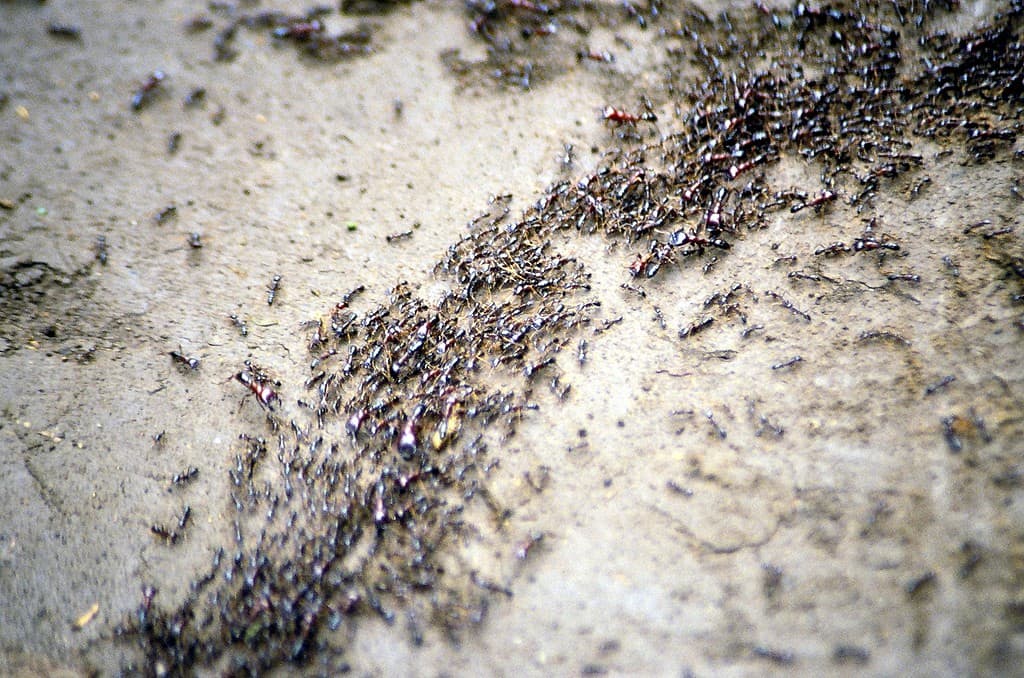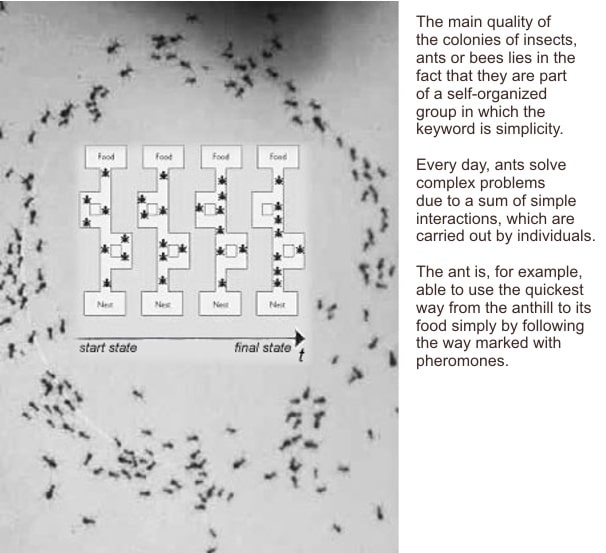
Scientists often look to unexpected places to find inspiration for algorithms — and this is one of those examples.
The ant colony algorithm is a pretty neat example of how nature inspires technological innovation. It starts from biological observations of real ant colonies. During these observations, scientists noticed how ants (seemingly unsophisticated creatures) could find the shortest path to food sources with remarkable efficiency.
So they thought of a way to take this efficient behavior and replicate it. Thus, the ant colony optimization (ACO) algorithm was born.
Think like an ant
The ACO is a technique in computer science and operations research designed to solve complex optimization problems. It works by simulating the pheromone trail laying and following behavior of ants, and then provides a probabilistic method to search for optimal paths or solutions. But let’s take it step by step.
The ant colony algorithm operates on the principle of simulating the foraging behavior of ants to find the shortest paths between their colony and food sources. At the heart of this algorithm are two key concepts: pheromone trails and probabilistic path selection.
Ants employ a form of chemical communication. When they travel, they deposit pheromones along their paths, and these chemical trails guide other ants to food sources. Over time, shorter paths accumulate more pheromones due to the faster return of ants, making them more attractive to follow.
So how do you translate that into an algorithm?

Well, the main challenge is finding a way to mimic ant behavior. In the computational model, artificial ants traverse a problem space, laying down and sensing virtual pheromones. Each ant is an agent that makes decisions probabilistically, favoring paths with stronger pheromones — but at the same time, they explore less traveled paths to discover potentially better solutions. The algorithm is an iterative one, repeating multiple times.
As the algorithm iterates, it updates “pheromone levels” based on the quality of solutions found, gradually converging towards the optimal path or solution.
Optimizing algorithms
In the biological world, this iterative process of exploration and exploitation, guided by pheromone-inspired feedback, enables the ant colony algorithm to effectively tackle complex optimization problems. In algorithms, this is mimicked in a dynamic adaptation to changing conditions. Just like ants put in the collective effort to find the best path, the artificial ants ensure continuous improvement and refinement of solutions.
In logistics, the ant colony algorithm is leveraged to optimize a variety of complex problems, from routing and scheduling to warehouse management and supply chain optimization. Logistics operations often involve finding the most efficient ways to distribute goods, manage fleets, and schedule deliveries. This is a challenging task due to the multitude of variables and constraints — but it’s not entirely different from how ants optimize their colony work.
For instance, in vehicle routing problems (VRP), the goal is to minimize the total distance traveled by a fleet while delivering to a set of locations. The ant colony algorithm excels in finding optimal or near-optimal routes by simulating the pheromone-laying process. It helps in identifying the shortest paths that meet delivery constraints, such as time windows and vehicle capacity, thus improving operational efficiency and reducing costs.
Similarly, in warehouse layout optimization, the algorithm can determine the most efficient arrangement of goods to minimize picking and packing times, enhancing the overall throughput of logistics operations. The algorithm can be used as a stand-alone tool or implemented in various logistics optimization software for a more streamlined and facile use.
Applying the algorithm to different fields
The application of this algorithm is significant in various fields, notably in logistics algorithms, where finding the most efficient routes and schedules can save a lot of time and money.
For instance, an e-commerce company may implement the ant colony algorithm to optimize its delivery routes. By simulating thousands of artificial ants to explore various routing options, companies can reduce delivery times significantly.
Another classic example is in supply chain network design. Supply chains don’t just happen — they are designed to be efficient. As we’ve seen during the recent pandemic, these supply chains are also quite vulnerable. So when something bad or unexpected happens and you need to redesign supply chains, it’s essential to minimize costs and maximize efficiency — and this is exactly the type of scenario in which the ant colony algorithm can make a difference.
The key advantage of the ant colony algorithm is that it excels at finding good solutions to complex optimization problems with multiple constraints, which are common in logistics. It is also quite adaptable and iterative, so if something changes along the way, it’s useful to find alternatives. But there are also constraints and limitations.
The main constraint is probably computation time. The algorithm can take a long time to compute larger problems. In addition, the algorithm doesn’t always necessarily find the best solution — sometimes it finds a suboptimal but functional solution, and doesn’t optimize from there onwards.
Several case studies and research projects have demonstrated the versatility and effectiveness of the ant colony algorithm in addressing complex logistics challenges. By optimizing routes, schedules, and network designs, companies can achieve significant efficiencies and cost savings.
With the rise of the Internet of Things (IoT) and smart city initiatives, the algorithm may also play a critical role in optimizing traffic flow, public transportation, and urban logistics, contributing to more sustainable and efficient urban environments.
The ant colony algorithm, inspired by the natural foraging behavior of ants, has found a significant place in logistics optimization — and already, a number of variants and extensions have been demonstrated. In short, we can expect this biology-inspired algorithm to play an even more significant role in the future.
Integrating new algorithms into strategic supply chain management
However, the most important thing for implementing any approach into supply chains is ensuring that it fits with existing structures.
Strategic supply chain management is all about crafting workable and optimized plans that act as the backbone of logistical operations. This approach requires meticulous planning and optimization to achieve seamless operations. The heart of this strategic integration lies in the union of cutting-edge logistics optimization software with the strategic foresight of supply chain management. So any extra component that is added must blend in perfectly with existing frameworks and not cause any issues.
The essentials of effective logistics planning—ranging from a clear strategic vision and data-driven insights to technology integration and continuous advancement—mirror the iterative learning and optimization processes observed in ant colonies. Just as ants adapt to their environment and continuously refine their paths, logistics operations must evolve through strategic planning and technological advancements.
Workable and optimized plans, a cornerstone of strategic supply chain management, provide a structured framework that complements the decentralized, exploratory nature of the ant colony algorithm. These plans ensure smooth resource coordination, minimize bottlenecks, and improve operational efficiency, thereby enhancing the logistics optimization process.
This integration highlights the importance of embracing a dual approach where strategy meets innovation, enabling businesses to craft logistics operations that are both efficient and adaptable. As we look towards the future, the symbiotic relationship between strategic supply chain management and ant colony algorithms will undoubtedly play a pivotal role in advancing the logistics field, ensuring that operations are not only optimized but also aligned with broader business objectives.
By blending the natural efficiency of ant-inspired algorithms with the structured approach of strategic planning, logistics operations can navigate complexities more effectively and achieve new heights of optimization.






